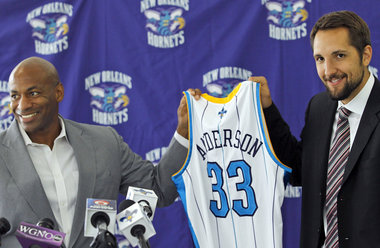« Beneath the Screen: Ryan Anderson and the Deep Ball
The Missing Piece: Getting Defensive »
Life without Superman – Ryan Anderson’s first month as a Hornet

With one month of the 2012-13 NBA season in the books, we’re finally starting to learn more about all of this Hornets team’s new faces and what they bring to the table on the court. Assumptions were made about many of these players before the season; while some of were right, others were a bit off the mark. Apart from the NBA future of the Hornets’ “other” first round pick, the most controversial topic among the Hornets’ off-season acquisitions was most likely what to expect from former Magic big man Ryan Anderson.
As most know, Anderson came from an Orlando team featuring Dwight Howard at center. As a result, there was a fair amount of skepticism regarding how much of Anderson’s strong numbers were achieved as a result of playing with as dominant of a force inside as Howard. Let’s take a look at last year’s results to see if there is evidence to support this theory.
Anderson with and without Howard – 2010-11 and 2011-12
Using the media stats tool from the official website of the NBA, I was able to obtain a great deal of data regarding Ryan Anderson’s performance while playing both with and without Dwight Howard. (If you want to see the results in full detail, you can access it here.) If you would prefer not to filter through all of those numbers, here is a summary below (click to enlarge).
Notes:
- Anderson took roughly the same number of 3-pointers while Howard was on and off of the court, but two more 2-pointers per 36 minutes while he was not playing than while he was. The additional two shots turned into about one more made shot, resulting in a points per 36 minutes total of 18.8 without Howard vs. 16.92 with him.
- Over the entire two year period, Anderson’s 3-point shooting percentages with vs. without Howard in the game were very similar. In 2010-11, he shot the ball better from deep when Howard was out, and in 2011-12, his shooting numbers from 3-point range were better when Howard was in. These results lead to assumptions of randomness to explain the disparity, though a part of it could be due to Anderson receiving more minutes against opposing starters without Howard, as Dwight was injured for part of last season. Unfortunately, I don’t have the necessary resources at my disposal to be able to dig into this possibility further, but it was worth mentioning.
- Most of Anderson’s other meaningful statistics were not very dependent on Howard’s presence on the court. Over the two year period, his turnovers, assists, steals, fouls, and offensive rebounds per 36 minutes were close to equal. He averaged about half a defensive rebound more (4.81 vs. 5.36) and half a block more (0.52 vs. 0.94) without Howard in the game, but those are two of the only real differences to be found.
The one giant takeaway from all of this is that, simply put, Ryan Anderson did not derive his offensive success from Dwight Howard’s ability to draw defensive attention away from him. I doubt many would argue that having a player like Howard on the floor would hurt a team’s spacing and efficiency on offense, but he certainly was not the reason that Ryan played so well. Additionally, his consistent play regardless of who he shared the court with is a positive indicator for when Anthony Davis and Eric Gordon recover from their respective injuries; any worries of Ryan’s role or production diminishing upon their return to the lineup can be discarded. Anderson is a smart and talented offensive player who proved that he could succeed in any situation over the past two seasons in Orlando.
Anderson’s First Month
Now that we’ve established that the guy can play no matter who his teammates are, it’s time to look at how he’s done so far this season. For some visual aids, Jake did a great in his post this morning of digging into how the Hornets are looking to get Anderson open and where he is shooting his threes. Here is his performance from a statistical perspective (click to enlarge):
When compared to his stats from the prior two seasons, two things stick out to me the most – free throws and 3-point percentage. Most of his per-36 minute numbers are right in line with what he’s done in the past, but his free throws and 3-point accuracy look very different. In Orlando, he averaged about three free throw attempts per 36 minutes, but in New Orleans he is shooting just under one per game. On the flip side, his 44.3% shooting from beyond the arc is remarkably high, easily surpassing his 39.3% mark over the past two years. These results explain why his effective field goal percentage is much higher than usual, yet his true shooting percentage only slightly higher than his 2010-11 and 2011-12 seasons. As this season wears on, expect both of these percentages to trend back towards what he averaged with the Magic; his current offensive rebound rate is well below his prior averages, so if he can bring that average back up, he’ll likely earn more free throw attempts through put-backs at the rim. Overall, his efficiency and total number of points produced should remain about the same.
Through one month of the 2012-13 NBA season, it appears even more clear that Ryan Anderson’s strong offensive production with the Orlando Magic was no Dwight Howard-fueled fluke. Anderson is a legit force on offense, and one who should only get better throughout the life of his current 4-year contract with the Hornets.







Pingback: Redemption | New Orleans Hornets | Hornets247.com
Pingback: New Orleans Hornets 2012-13 Power Rankings – Week 5 | New Orleans Hornets | Hornets247.com